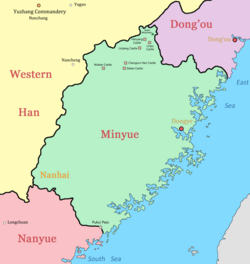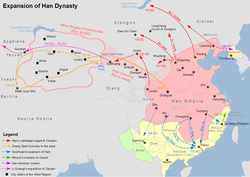Dong'ou | |||||||||
|---|---|---|---|---|---|---|---|---|---|
| 191 BC | |||||||||
 Map of Dong'ou | |||||||||
 The location of Dong'ou kingdom before the conquest of the Han dynasty | |||||||||
| Status | Kingdom | ||||||||
| Capital | Dong'ou (modern Wenzhou) | ||||||||
| Government | Monarchy | ||||||||
| King | |||||||||
• 191–185 BCE | Yao (搖) | ||||||||
• 185–138 BCE | Zhenfu (貞復) | ||||||||
• 138–138 BCE | Wang (望) | ||||||||
| History | |||||||||
• Established | 191 BC | ||||||||
• Defeated by Minyue | 138 BC | ||||||||
| 111 BC | |||||||||
| |||||||||
| Today part of | China | ||||||||
Dong'ou (simplified Chinese: 东瓯; traditional Chinese: 東甌; pinyin: Dōng'ōu) also known as Ouyue (simplified Chinese: 瓯越; traditional Chinese: 甌越; pinyin: Ōuyuè), was an ancient kingdom in modern Wenzhou and Taizhou, Zhejiang Province, China. The realm of Dong'ou was given to Zou Yao by Emperor Gaozu of Han in 192 BC. During the Han campaigns against Minyue in 138 BC, the king of Dong'ou no longer wished to live in his realm after the incident, having submitted himself in an prostrating gesture, which was indicative of his final acquiescence as a mere supplicant to have him and his people's eventual fates to be absorbed into the Han empire.[4][5] After Zou Yushan's unsuccessful uprising against General Yang Pu's conspiratorial intentions to subvert him, which aimed to protect Dongyue's independence, the aspiration for autonomous control over Dongyue gradually dissipated during the final months of 111 BC. Zou's uprising was suppressed, prompting the Han dynasty to eventually incorporate Dongyue and the remaining territories of the former Minyue, thereby permanently securing the complete annexation and assimilation of both domains into the Han empire.[1][2][3]
- ^ a b Yu 1986, p. 456.
- ^ a b Lorge 2012, p. 85.
- ^ a b Sima & Watson 1993, p. 223.
- ^ Whiting 2002, p. 145.
- ^ Watson 1993, p. 222.